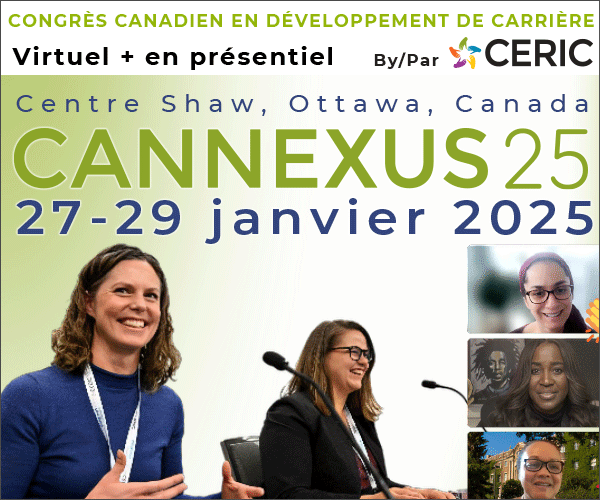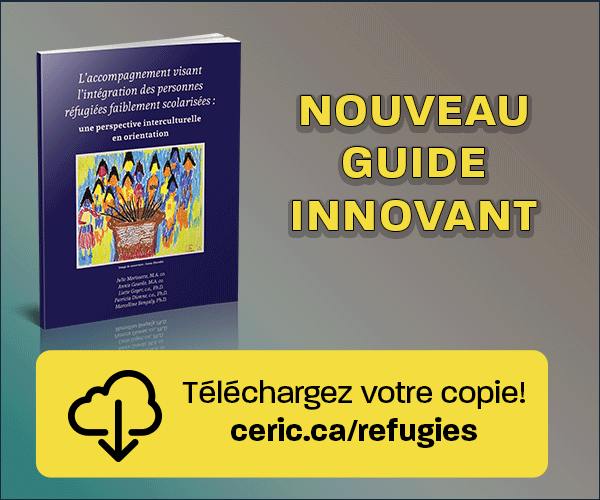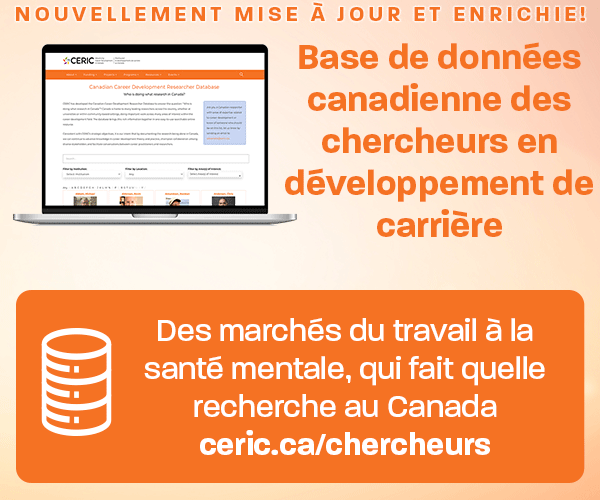Planifier la vie en dehors du sport : comportements de recherche d’aide des athlètes d’élite à l’égard des ressources de soutien à la carrière
DOI :
https://doi.org/10.53379/cjcd.2023.359Mots-clés :
recherche d'aide, soutien à la carrière, athlète, retraiteRésumé
Malgré les résultats illustrant que la planification de la transition hors du sport est associée à des réponses émotionnelles plus positives et à moins de difficultés à la retraite, seule une petite proportion d'athlètes utilise les ressources disponibles via les programmes de soutien. Cette étude examine les facteurs associés aux non-recours envers les ressources de soutien à la carrière de 191 athlètes d'élite canadiens. Des informations sur les obstacles perçus à la recherche d'aide, le niveau d'engagement dans une carrière en dehors du sport et l'utilisation des ressources ont été recueillies à l'aide d'un sondage. Les résultats des analses descriptives et prédictives indiquent trois principaux obstacles perçus à la recherche d'aide : le manque de temps (51,8 %), le manque de connaissances (35,1 %) et la peur de la stigmatisation associée à l'utilisation des ressources de soutien de carrière (12,6 %). L'âge de l'athlète, la catégorie de sport (hiver, été) et le niveau d'engagement dans une carrière en dehors du sport sont des prédicteurs de l'utilisation des ressources de soutien de carrière.
Références
Alfermann, D., Stambulova, N., & Zemaityte, A. (2004). Reactions to sport career termination : A cross-national comparison of German, Lithuanian, and Russian Athletes. Psychology of Sport and Exercise, 5(1), 61 75. https://doi.org/10.1016/S1469-0292(02)00050-X
Blakelock, D. J., Chen, M. A., & Prescott, T. (2016). Psychological distress in elite adolescent soccer players following deselection. Journal of Clinical Sport Psychology, 10, 59 77. https://doi.org/10.1123/jcsp.2015-0010
Brown, C. (2008). Developmental Psychology. SAGE.
Brownrigg, A., Burr, V., Locke, A., & Bridger, A. (2012). You don’t know what’s around the corner: A qualitative study of professional footballers in England facing career transition. Qualitative methods in psychology bulletin, 14, 14 23.
Crook, J., & Robertson, S. (1991). Transitions out of elite sport. International Journal of Sport Psychology, 22, 115 127.
D’Angelo, C., Reverberi, E., Gazzaroli, D., & Gozzoli, C. (2017). At the end of the match : exploring retirement of italian football players. Journal of Sport Psychology, 26(3), 130-134.
DeLenardo, S., & Terrion, J. L. (2014). Suck it up : Opinions and attitudes about mental illness stigma and help-seeking behavior of male varsity football players. Canadian Journal of Community Mental Health, 33(3), 43 56. https://doi.org/10.7870/cjcmh-2014-023
Di Fabio, A., & Maree, J. G. (2013). Effectiveness of the career interest profile. Journal of Employment Counseling, 50(3), 110 123. https://doi.org/10.1002/j.2161-1920.2013.00030.x
Fouad, N. A., Guillen, A., Harris-Hodge, E., Henry, C., Novakovic, A., Terry, S., & Kantamneni, N. (2006). Need, awareness, and use of career services for college students. Journal of Career Assessment, 14(4), 407 420. https://doi.org/10.1177/1069072706288928
Friesen, A. C., & Orlick, T. (2011). Holistic sport psychology : Investigating the roles, operating standards, and intervention goals and strategies of holistic consultants. Journal of Excellence, 14, 18 42.
Game Plan (2019). Statistic of usage of services [Unpublished report]. Game Plan program, Montreal, Canada.
Game Plan (2020). Statistic of usage of services [Unpublished report]. Game Plan program, Montreal, Canada.
Givens, J. L., & Tjia, J. (2002). Depressed medical students’ use of mental health services and barriers to use. Academic Medicine, 77, 918–921. https://doi.org/10.1097/00001888-200209000-00024
Gulliver, A., Griffiths, K. M., & Christensen, H. (2012). Barriers and facilitators to mental health help-seeking for young elite athletes : A qualitative study. BMC Psychiatry, 12(1). https://doi.org/10.1186/1471-244X-12-157
Henriksen, K., Schinke, R., Moesch, K., McCann, S., Parham, W. D., Larsen, C. H., & Terry, P. (2020). Consensus statement on improving the mental health of high performance athletes. International Journal of Sport and Exercise Psychology, 18(5), 553 560. https://doi.org/10.1080/1612197X.2019.1570473
Henriksen, K., & Stambulova, N. (2017). Creating optimal environments for talent development. In J. Baker (Éd.), Routledge Handbook of Talent Identification and Development in Sport (1st éd., pp. 15). Routledge.
Henriksen, K., Stambulova, N., & Roessler, K. K. (2010). Holistic approach to athletic talent development environments : A successful sailing milieu. Psychology of Sport and Exercise, 11(3), 212 222. https://doi.org/10.1016/j.psychsport.2009.10.005
Hirschi, A., Freund, P. A., & Herrmann, A. (2014). The career engagement scale : Development and validation of a measure of proactive career behaviors. Journal of Career Assessment, 22(4), 575–594. https://doi.org/10.1177/1069072713514813
Kerr, G., & Dacyshyn, A. (2000). The retirement experiences of elite, female gymnasts. Journal of Applied Sport Psychology, 12(2), 115 133. https://doi.org/10.1080/10413200008404218
Lally, P., & Kerr, G. (2005). The career planning, athletic identity, and student role identity of intercollegiate student athletes. Research Quarterly for Exercise and Sport, 76(3), 275 285.
Larsen, C. H., Alfermann, D., Henriksen, K., & Christensen, M. K. (2013). Successful talent development in soccer : The characteristics of the environment. Sport, Exercise, and Performance Psychology, 2(3), 190 206. https://doi.org/10.1037/a0031958
Lavallee, D., & Robinson, H. K. (2007). In pursuit of an identity : A qualitative exploration of retirement from women’s artistic gymnastics. Psychology of Sport and Exercise, 8(1), 119 141. https://doi.org/10.1016/j.psychsport.2006.05.003
López, R. L., & Levy, J. J. (2013). Student athletes’ perceived barriers to and preferences for seeking counseling. Journal of College Counseling, 16(1), 19 31. https://doi.org/10.1002/j.2161-1882.2013.00024.x
Ludwikowski, W. M. A., Vogel, D., & Armstrong, P. I. (2009). Attitudes toward career counseling : The role of public and self-stigma. Journal of Counseling Psychology, 56(3), 408 416. https://doi.org/10.1037/a0016180
McArdle, S., Moore, P., & Lyons, D. (2014). Olympic athletes’ experiences of a post games career transition program. Sport Psychologist, 28(3), 269 278. https://doi.org/10.1123/tsp.2013-0046
North, J., & Lavallee, D. (2004). An investigation of potential users of career transition services in the United Kingdom. Psychology of Sport and Exercise, 5(1), 77 84. https://doi.org/10.1016/S1469-0292(02)00051-1
Robertson, P. J. (2016). Identifying and measuring capabilities for career development in NEET young people. Recherches sociologiques et anthropologiques, 47(2), 83 99. https://doi.org/10.4000/rsa.1738
Seanor, M., Schinke, R. J., Stambulova, N. B., Ross, D., & Kpazai, G. (2017). Cultivating olympic champions : A trampoline development environment from grass roots to podium. Journal of Sport Psychology in Action, 8(2), 96 108. https://doi.org/10.1080/21520704.2017.1327908
Stambulova, N. B., & Ryba, T. V. (Éds.). (2013). Athletes’ careers across cultures. Routledge.
Stambulova, N. B., Ryba, T. V., & Henriksen, K. (2020). Career development and transitions of athletes : The International Society of Sport Psychology Position Stand Revisited. International Journal of Sport and Exercise Psychology, 1 27. https://doi.org/10.1080/1612197X.2020.1737836
Van Neutegem, A. (2011). Programme canadien d’accompagnement à la transition et d’orientation professionnelle pour les athlètes d’élite : Rapport administratif et recommendations. Collège Camosun et l’institut de sport d’excellence du Pacifique.
Wahto, R. S., Swift, J. K., & Whipple, J. L. (2016). The role of stigma and referral source in predicting college student-athletes’ attitudes toward psychological help-seeking. Journal of Clinical Sport Psychology, 10(2), 85 98. https://doi.org/10.1123/JCSP.2015-0025
Watson, J. C. (2006). Student-athletes and counseling: factors influencing the decision to seek counseling services. College Student Journal, 40(1), 35 42.
Webb, W. M., Nasco, S. A., Riley, S., & Headrick, B. (1998). Athlete identity and reactions to retirement from sports. Journal of Sport Behavior, 21(3), 338 362.
Wood, S., Harrison, L. K., & Kucharska, J. (2017). Male professional footballers’ experiences of mental health difficulties and help-seeking. The Physician and Sportsmedicine, 45(2), 120-128. https://doi.org/10.1080/00913847.2017.1283209
Wylleman, P., Alfermann, D., & Lavallee, D. (2004). Career transitions in sport : European perspectives. Psychology of Sport and Exercise, 5(1), 7 20. https://doi.org/10.1016/S1469-0292(02)00049-3
Zunker, V. G. (2016). Career counseling : A holistic approach (9th edition). Cengage Learning.

Téléchargements
Publié-e
Comment citer
Numéro
Rubrique
Licence
(c) Tous droits réservés La Revue canadienne de développement de carrière 2023

Cette œuvre est sous licence Creative Commons Attribution - Pas d'Utilisation Commerciale - Pas de Modification 4.0 International.











